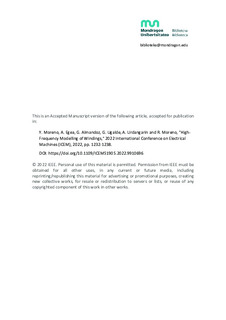Title
High-Frequency Modelling of WindingsPublication Date
2022Other institutions
ORONA - EIC. S.COOP.Ikerlan
Version
PostprintDocument type
Conference ObjectConference ObjectLanguage
EnglishRights
© 2022 IEEEAccess
Embargoed accessEmbargo end date
2024-10-31Publisher’s version
https://doi.org/10.1109/ICEM51905.2022.9910696Published at
2022 International Conference on Electrical Machines (ICEM) Valencia 05-08 September 2022. IEEEPublisher
IEEEKeywords
Coils
Analytical models
Impedance measurement
Computational modeling ... [+]
Analytical models
Impedance measurement
Computational modeling ... [+]
Coils
Analytical models
Impedance measurement
Computational modeling
Windings
Conductors
Finite element analysis [-]
Analytical models
Impedance measurement
Computational modeling
Windings
Conductors
Finite element analysis [-]
Abstract
Electrical drives consume a great amount of the world’s energy, and this will keep increasing due to the electromobility trend. Hence, the efficiency of electrical drives must be improved to reach sus ... [+]
Electrical drives consume a great amount of the world’s energy, and this will keep increasing due to the electromobility trend. Hence, the efficiency of electrical drives must be improved to reach sustainability. Silicon Carbide devices have a high working frequency and lower switching loss, increasing the device efficiency. Nevertheless, higher operation frequencies may bring major Electromagnetic Compatibility issues, in addition to insulation stress and higher bearing currents. This paper presents the simulation process to obtain a high-frequency model of an electrical machine. Then, some small and controlled coils are modelled to construct the high-frequency model step by step, analysing the slight differences between conductor diameters and materials that would be difficult to see in a machine. These models are validated with experimental impedance measurements. This represents the first step in modelling an electrical machine equivalent circuit to predict the electromagnetic interference levels from the design stage. [-]





















